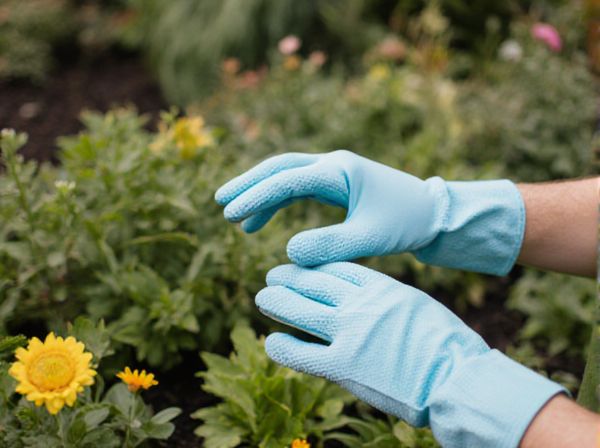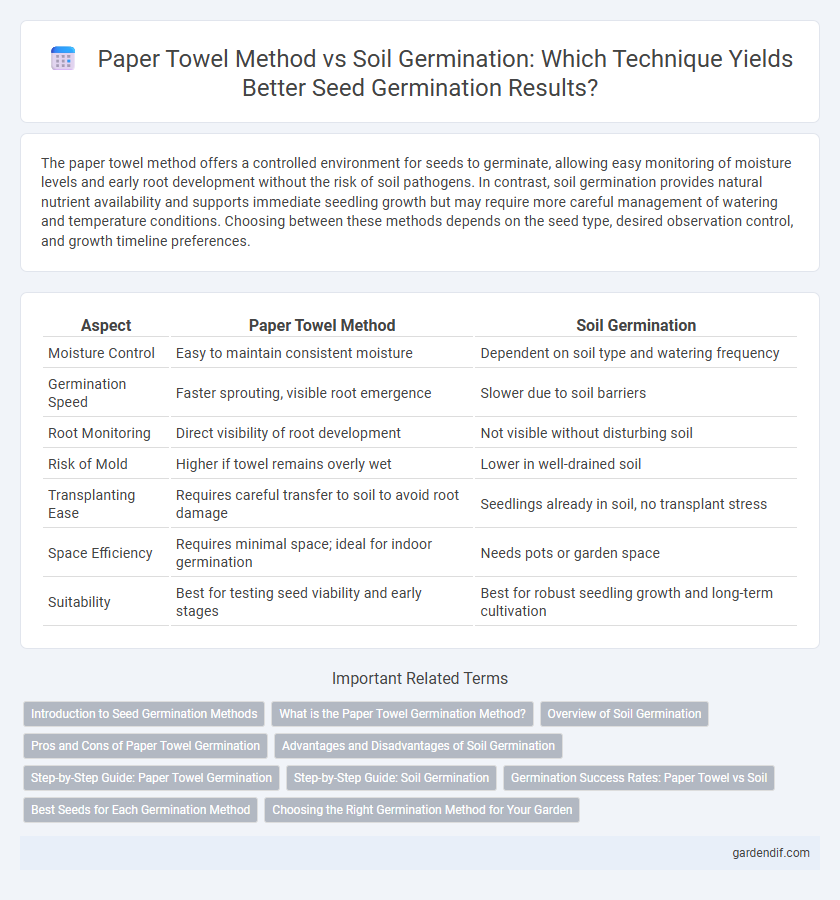
Paper Towel Method vs Soil Germination Illustration
The paper towel method offers a controlled environment for seeds to germinate, allowing easy monitoring of moisture levels and early root development without the risk of soil pathogens. In contrast, soil germination provides natural nutrient availability and supports immediate seedling growth but may require more careful management of watering and temperature conditions. Choosing between these methods depends on the seed type, desired observation control, and growth timeline preferences.
Table of Comparison
| Aspect | Paper Towel Method | Soil Germination |
|---|---|---|
| Moisture Control | Easy to maintain consistent moisture | Dependent on soil type and watering frequency |
| Germination Speed | Faster sprouting, visible root emergence | Slower due to soil barriers |
| Root Monitoring | Direct visibility of root development | Not visible without disturbing soil |
| Risk of Mold | Higher if towel remains overly wet | Lower in well-drained soil |
| Transplanting Ease | Requires careful transfer to soil to avoid root damage | Seedlings already in soil, no transplant stress |
| Space Efficiency | Requires minimal space; ideal for indoor germination | Needs pots or garden space |
| Suitability | Best for testing seed viability and early stages | Best for robust seedling growth and long-term cultivation |
Introduction to Seed Germination Methods
Seed germination methods vary in efficiency, with the paper towel method providing a controlled, moisture-retentive environment that accelerates germination by maintaining optimal hydration levels. Soil germination mimics natural conditions, offering nutrients and microbial interactions essential for seedling development but may pose challenges like inconsistent moisture and pest exposure. Selecting the appropriate method depends on the seed type, desired germination rate, and growth monitoring preferences.
What is the Paper Towel Germination Method?
The Paper Towel Germination Method involves placing seeds between moist paper towels to create a controlled, moisture-rich environment that promotes faster and more uniform sprouting. This technique allows for easy monitoring of seed progress and ensures consistent hydration without the risk of overwatering common in soil germination. It is widely favored for seed viability testing and early-stage germination before transplanting into soil.
Overview of Soil Germination
Soil germination involves planting seeds directly into nutrient-rich, well-draining soil that provides stable moisture and aeration essential for seed development. This natural medium supports root growth and mimics outdoor conditions, enhancing seedling vigor and resilience. Compared to the paper towel method, soil germination reduces transplant shock by establishing seedlings in their permanent growing environment from the start.
Pros and Cons of Paper Towel Germination
Paper towel germination offers rapid seed sprouting and easy monitoring of root development, making it ideal for controlled environment experiments and early-stage growth assessment. It requires minimal space and water compared to soil germination but lacks nutrient availability and protection from pathogens, which can hinder seedling vigor beyond the initial rooting phase. This method can lead to delicate root systems prone to damage during transplantation, making soil germination more reliable for sustained seedling development.
Advantages and Disadvantages of Soil Germination
Soil germination provides natural nutrients and moisture retention, creating an ideal environment for seedling development, which enhances root establishment and overall plant health. However, the risk of soil-borne diseases and pests, along with variable moisture levels and potential poor drainage, can impede germination success compared to the controlled conditions of the paper towel method. Soil germination typically requires more space and monitoring, making it less convenient for small-scale or indoor planting projects.
Step-by-Step Guide: Paper Towel Germination
Place seeds between moist paper towels, ensuring even moisture without oversaturation to promote optimal germination. Keep the towels in a warm, dark environment, such as inside a sealed plastic bag or container, to maintain humidity and temperature stability. Check daily for sprout emergence and transfer seedlings carefully to soil once roots reach 1-2 centimeters for successful growth transition.
Step-by-Step Guide: Soil Germination
Begin soil germination by selecting high-quality seeds and filling a seed tray or pots with nutrient-rich, well-draining soil. Moisten the soil evenly and plant seeds at the recommended depth, typically twice the seed's size, ensuring proper spacing to avoid overcrowding. Maintain consistent moisture and warmth, ideally between 65-75degF (18-24degC), while providing indirect sunlight until seedlings emerge and establish strong roots.
Germination Success Rates: Paper Towel vs Soil
The paper towel method offers high germination success rates by providing controlled moisture and temperature conditions, often reaching up to 90-95% germination for many seed types. In contrast, soil germination success can vary widely, typically between 70-85%, due to factors like uneven moisture distribution, soil pathogens, and temperature fluctuations. Seeds germinated on paper towels require careful handling during transplant to soil, whereas soil germination allows seeds to develop naturally in their growth medium, impacting overall seedling vigor and survival rates.
Best Seeds for Each Germination Method
Seeds with delicate outer shells like lettuce and basil perform exceptionally well using the paper towel method due to controlled moisture and easy monitoring. Hardy seeds such as beans, tomatoes, and peppers thrive better in soil germination, benefiting from the natural nutrients and stable environment soil provides. Selecting the optimal germination method enhances sprouting success rates and seedling vigor for specific seed types.
Choosing the Right Germination Method for Your Garden
Paper towel germination offers precise control over moisture and temperature, accelerating seed sprouting and allowing easy monitoring of progress. Soil germination, however, better mimics natural growing conditions, providing vital nutrients and microbial interaction that support robust root development. Selecting the right germination method depends on seed type, environmental factors, and desired seedling resilience for successful garden establishment.
Paper Towel Method vs Soil Germination Infographic

 gardendif.com
gardendif.com